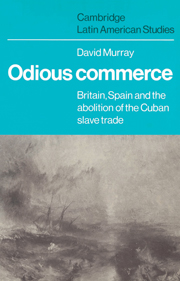Book contents
- Frontmatter
- Contents
- Tables
- Preface
- 1 The ‘opening’ of a legal trade
- 2 Parliament versus Cortes
- 3 Legality and illegality
- 4 The treaty of 1817
- 5 Enforcement and re-enforcement: the attempt to make the slave trade prohibition effective
- 6 The treaty of 1835
- 7 An abolitionist era
- 8 The Turnbull affair
- 9 The Escalera conspiracy
- 10 The penal law of 1845
- 11 Free trade and annexationism
- 12 The failure of the penal law
- 13 A new class of slaves
- 14 The abolition of the Cuban slave trade
- Abbreviations
- Notes
- Bibliography
- Index
- CAMBRIDGE LATIN AMERICAN STUDIES
6 - The treaty of 1835
Published online by Cambridge University Press: 16 October 2009
- Frontmatter
- Contents
- Tables
- Preface
- 1 The ‘opening’ of a legal trade
- 2 Parliament versus Cortes
- 3 Legality and illegality
- 4 The treaty of 1817
- 5 Enforcement and re-enforcement: the attempt to make the slave trade prohibition effective
- 6 The treaty of 1835
- 7 An abolitionist era
- 8 The Turnbull affair
- 9 The Escalera conspiracy
- 10 The penal law of 1845
- 11 Free trade and annexationism
- 12 The failure of the penal law
- 13 A new class of slaves
- 14 The abolition of the Cuban slave trade
- Abbreviations
- Notes
- Bibliography
- Index
- CAMBRIDGE LATIN AMERICAN STUDIES
Summary
When the Duke of Infantado informed the British Minister in Madrid of the royal order of 1826, he asked Lamb if the British government could suggest any other measure which would help to suppress the slave trade. Canning responded to this opening with a proposal that Spain follow Holland's example and sign an equipment article which would then mean that suspected Spanish slavers, equipped to carry on the slave trade, could be seized and condemned even if they did not have slaves on board. This proposal was made official in a Note addressed to the Spanish Foreign Minister on 19 February 1826. The suggestion was then turned over to the Council of the Indies for study. Their report was quite favourable. The Council did not find any objection to the additional article, although it felt more ought to be done to make the existing laws effective. Should the equipment article be approved, the Council recommended a six-month period of grace to date from the publication of the new article, and it believed that the punishment for infractions should be limited to the confiscation of the ship and its cargo.
Ferdinand referred the report to his Council of State which, in turn, asked the Spanish Foreign Minister for his opinion; however, before the Duke of Infantado had a chance to examine the problem he was replaced as Foreign Minister. A Foreign Ministry memorandum succinctly describes what happened next: ‘here the affair remained paralysed’.
- Type
- Chapter
- Information
- Odious CommerceBritain, Spain and the Abolition of the Cuban Slave Trade, pp. 92 - 113Publisher: Cambridge University PressPrint publication year: 1981



